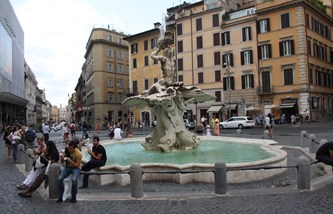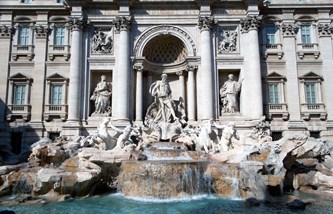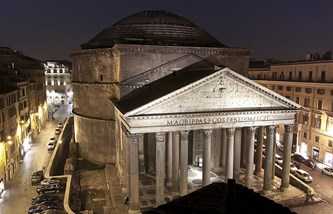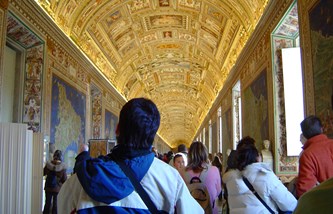Tours

Rome Tourist Card
Rome Tourist Card
Snap up the Rome Tourist Card and you'll get everything you need to explore Rome's top highlights including Colosseum, Palatine Hill, Roman Forum and Hop on/off bus. You can even choose the order you see things in.

Colosseum, Roman Forum & Palatine Hill: Priority Entrance
Colosseum, Roman Forum & Palatine Hill: Priority Entrance
Skip the long lines at the Colosseum with this priority-entrance ticket. This ticket will let you bypass the crowds. And after exploring the Colosseum you can head to the area of the Roman Forum and the Palatine Hill.
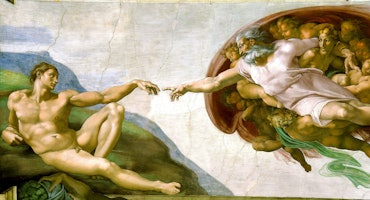
Vatican Museums & Sistine Chapel: Skip The Line
Vatican Museums & Sistine Chapel: Skip The Line
This ticket will make you save stress and time by allowing you to get priority entrance and skip the line. Visit the the countless masterpieces by Michelangelo, Raphael, Caravaggio, Tiziano and the Sistine chapel.
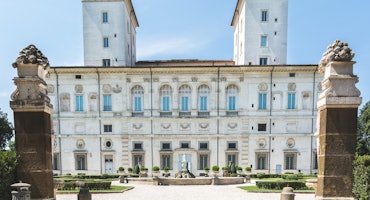
Borghese Gallery: Fast Track
Borghese Gallery: Fast Track
Galleria Borghese is located in the villa of the park Villa Borghese. Admire the architecture and furnishings of this beautiful villa. It is a museum full of art from the Renaissance. The collection includes several sculptures and paintings. Because of limited capacity get tickets for this museum weeks in advance.
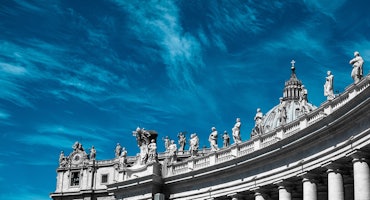
St. Peter’s Basilica: Dome Climb with Guide
St. Peter’s Basilica: Dome Climb with Guide
Get the most out of your visit to St. Peters with a guided tour to climb the basilica’s dome designed by Michelangelo and admire one of the stunning view. After the tour, you can explore the the basilica at your own pace.
The Fountain of the Four Rivers
For thousands of years, the fountains of Rome have been an essential part of life in the Eternal City. Before indoor plumbing made its way into local homes, fountains were the primary means in which Romans gathered fresh water. The tradition of fountains survived millennia of Roman history, and they’re still an essential part of the city. And one of the most iconic is the Fountain of the Four Rivers, in the heart of Piazza Navona.
For centuries, the Pope was the main authority of Rome, in charge of everyday infrastructure business. And, during the times of Baroque art, beautiful fountains were often the Pope’s gifts to the city, showcasing his generosity and commitment to Romans as good Catholics. 17th-century Pope Innocent X, a skilled and shrewd politician, also wanted to leave his own mark in the city while also honoring his family, the Pamphilis, a highly influential papal dinasty of those days. He requested an imposing fountain in front of his family’s home, Palazzo Pamphili, and there was an open competition for the great artists of Rome.

The Forbidden Artist
There was just the artist for the job, who imagined the design we see today in 1651, yet he wasn’t supposed to participate in the competition. Baroque sculptor and architect Gian Lorenzo Bernini was barred from throwing his hat on the table for the new Piazza Navona fountain. Master Bernini had worked closely with the previous pontiff, Pope Urban VIII, who belonged to the Barberini papal family, rivals to the Pamphilis. Bernini was out of favor with the current government, but that wasn’t going to keep him out!
Still, Bernini knew his worth and designed the beautiful Fountain of the Four Rivers Rome we see today. Named Fontana dei Quattro Fiumi in Italian, the fountain was a symbol of the influence of the Catholic Church and a tip of the hat to the pope’s family legacy. When Pope Innocent X saw Bernini’s design, he commissioned it instantly. It is said that the pope hired him despite his best wishes, because he felt he had no other choice. “The only way not to employ Bernini,” the Pope reportedly said, “is to never see his designs.”
As it stands now, the Four Rivers Fountain is the largest and arguably most famous of Bernini’s works. It was built between 1648 and 1651. Bernini’s students helped the master design and build the monument, as it was fashionable in Italian art at the time.
The Fountain of the Four Rivers Symbology
The Fontana dei Quattro Fiumi represents the four major rivers that cartographers believed existed during the Renaissance and Baroque years. More importantly, they represent the influence of the Holy See and the Pope in four continents, through depictions of river gods: the Nile for Africa, the Ganges for Asia, the Danube for Europe and the Río de la Plata for the Americas.
The river gods also refer to the rivers of paradise. Actually, the whole fountain is heavily allegorical and full of metaphors, with intricate designs (as per the Baroque periods) heavy on symbology. Here are some of the most interesting bits of information about the statues depicted in the fountain:
• The face of the Nile river god is not visible, as in those days geographers didn’t know where this body of water began. Instead, his face is covered by a piece of cloth.
• Due to the Ganges’ renowned navigability, its river god carries an oar.
• In those days, the Americas were still European colonies, and they were seen as a grand source of riches for the Church. Because of that, the Río de la Plata depiction sits on a pile of coins.
• As a representation of Europe and the body of water closest to Rome, the head of the Danube river god touches Pope Innocent X’s personal coat of arms.
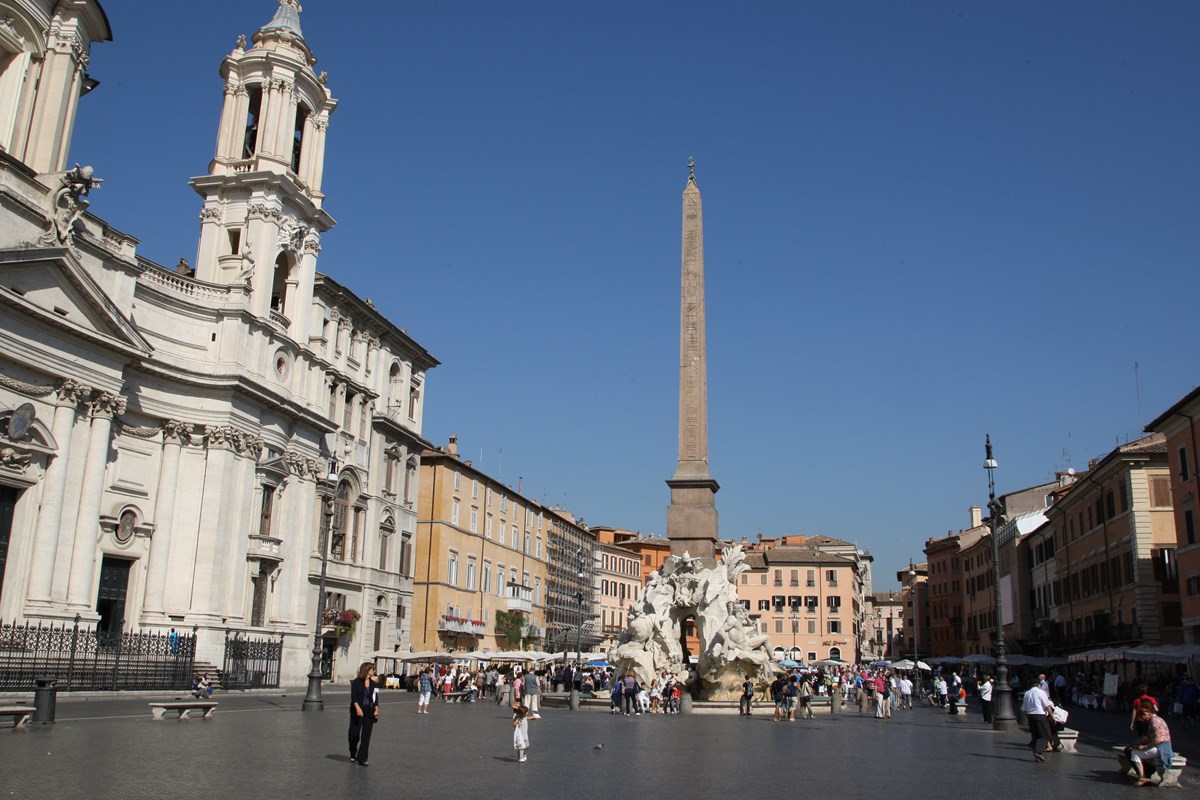
The fountain isn’t just about the continents and rivers it represents, as there’s also bits about the Catholic Church and the Pamphili family. Each of the river gods is semi-kneeling, like they’re all serving a central power, the representation of Rome’s papal power. At the center lies an Egyptian obelisk built for the Serapeum of Roman Emperor Domitian in AD 81. Inscribed, there’s a dove carrying an olive twig. While the dove is an ancient depiction of the Church and the Holy spirit, it was also the Pamphili family emblem.
Water sprouts from all directions with no pattern as well: the Church is grand, all-powerful and with an immense reach throughout the continents.
More on Piazza Navona
One of the main squares of Rome, Piazza Navona contains many attractions. Here’s a quick guide to some of the others:
• The Fountain of Neptune. Located at the northern end of the square, this is the newest Piazza Navona Square, completed in 1878. It has several impressive statues with Roman mythology themes. The basin of the fountain is older. It was designed by the architect Giacomo della Porta in 1575.
• The Moor’s Fountain. Another example of Bernini’s fountains lies on the piazza’s southern end. It was originally made by the Renaissance master and Michaelangelo apprentice Giacomo della Porta, and Bernini added details centuries later.
• Palazzo Braschi. Home to the Museo di Roma, it houses a magnificent collection of Italian art. It’s also architecturally interesting, as it’s a beautiful 18th century palace.
• Sant’Agnese in Agone. Also built under the patronage of Pope Innocent X, this was made as the Pamphili family’s personal chapel. This Baroque beauty stands where early Christian Saint Agnes was martyrized. If you want to know more about this church, you can visit our Sant'Agnese in Agone page.
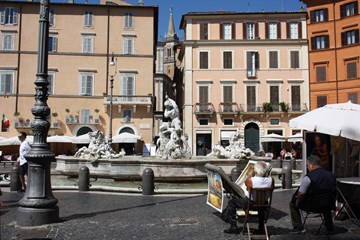
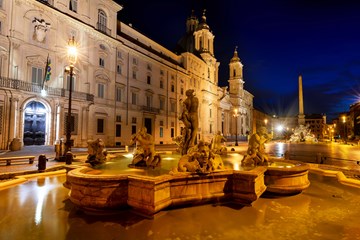
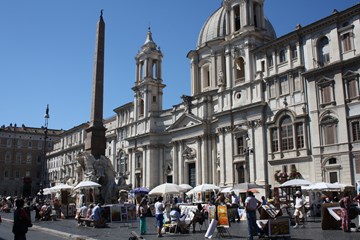
How to Get to the Fountain of the Four Rivers Rome
Here’s a quick guide on how to reach Piazza Navona to enjoy the sights of the fontana:
• Metro. The nearest metro station is still kind of far, about 1.2 km away. If you still prefer this medium, you can get out at Spagna on Line A and walk for about 20 minutes to Piazza Navona.
• Bus. Piazza Navona is well connected through buses, some of which are the no. 87 (which you can take outside the Line B Colosseo station), no. 70 (from Termini, Line A or Line B) and no. 492 (from Piazza Barberini, Line A).
Essential Fontana dei Quattro Fiumi Info
• Address. Piazza Navona, 00186 (Piazza Navona).
• Schedule. The fountain is part of a public square, and you can come in and visit at any time of the day or night. Don’t miss the sights during the nighttime’s lights or even catch a sunrise and sunset for a mix of art and magical natural colors!
FAQ
Which rivers are represented in the Fountain of the Four Rivers?
The fountain represents four major rivers in four different continents: the Danube in Europe, the Río de la Plata in the Americas, the Ganges in Asia and the Nile in Egypt.
What are the Piazza Navona fountains?
There are three fountains in Piazza Navona: the Fountain of Neptune (northern end of the square), the Moor's Fountain (southern end) and the Fountain of the Four Rivers (at the center).
Who built the Fountain of the Four Rivers?
It was built by Baroque art master Gian Lorenzo Bernini.
Which Rome metro is closest to Piazza Navona?
The nearest metro station is Spagna on Line A, which is 1.2 km away. If you want to walk a little less, you can take bus lines 87, 70 or 492.
